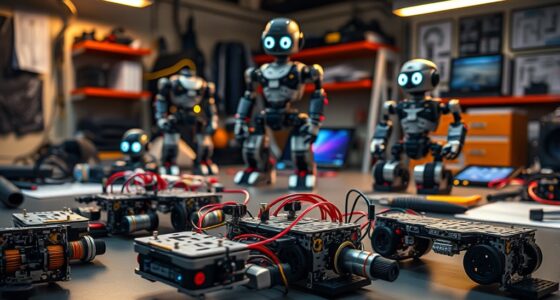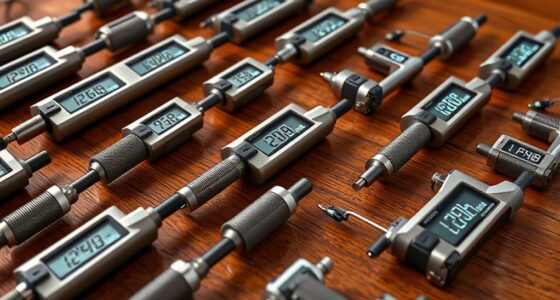In 2025, the top high-end DNA sequencers for precision and power are the Illumina NovaSeq X and Pacific Biosciences Sequel IIe. They offer exceptional accuracy, high throughput, and reliable performance for advanced genomics and clinical use. The NovaSeq X excels in speed and data capacity, while the Sequel IIe provides remarkable long-read capabilities. To find out how these cutting-edge machines could transform your research, stick with me as I explore their features in detail.
Key Takeaways
- Prioritize sequencers with ≥99.9% accuracy, long read lengths, and high throughput for comprehensive and precise genome analysis.
- Look for platforms offering seamless integration with bioinformatics tools, cloud compatibility, and automation features for efficient workflows.
- Consider models with robust support, reliable maintenance, and proven durability to ensure continuous high-performance operation.
- Evaluate total costs, including initial investment, consumables, and operational expenses, to select cost-effective, sustainable options.
- Opt for systems with advanced error correction, flexible chemistries, and comprehensive data analysis capabilities for cutting-edge research.
Innovating Science DNA Extraction Kit
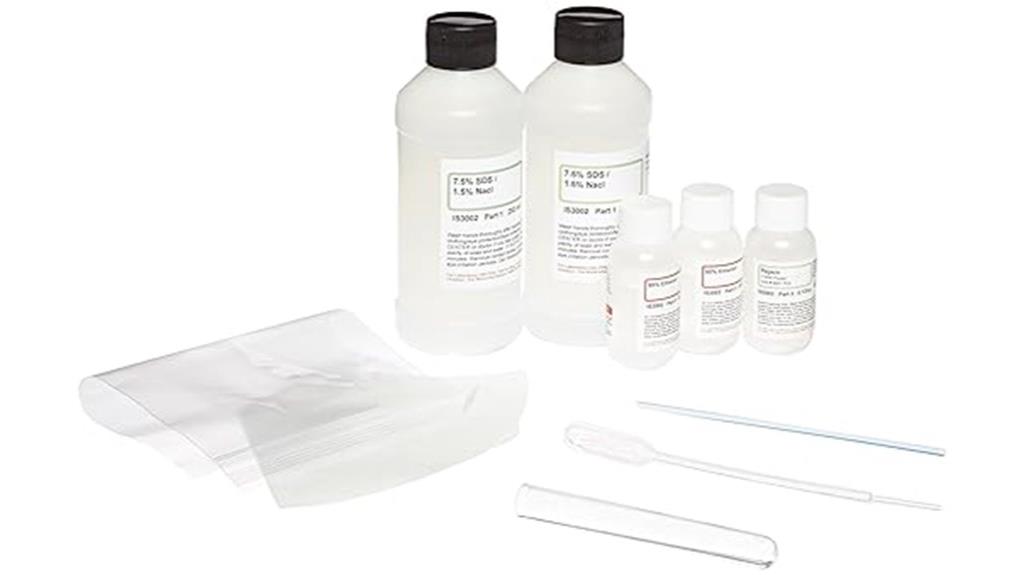
The Innovating Science DNA Extraction Kit is the perfect choice for educators and students age 13 and up who want hands-on experience with fundamental genetic concepts. I’ve used this kit in my classroom, and it truly brings biology to life. It includes everything needed for 15 groups to extract DNA from plant material, supporting active learning. The step-by-step instructions and safety materials make it easy to implement. Plus, it offers a tangible way to understand DNA’s structure, inheritance, and gene expression. This kit effectively combines science theory with practical skills, making complex topics accessible and engaging for students.
Best For: educators and students aged 13+ seeking a hands-on, engaging introduction to genetic concepts through DNA extraction experiments.
Pros:
- Provides comprehensive materials for 15 student groups, supporting collaborative learning
- Includes detailed step-by-step instructions and safety resources for easy implementation
- Encourages active participation and reinforces understanding of DNA structure, inheritance, and gene expression
Cons:
- Designed primarily for classroom use, may require adult supervision for younger students
- Limited to plant material, so may not be suitable for studies involving animal or microbial DNA
- Requires additional safety precautions due to the use of chemicals like ethanol and SDS
Extech PRT200 Non-Contact Phase Sequence Tester
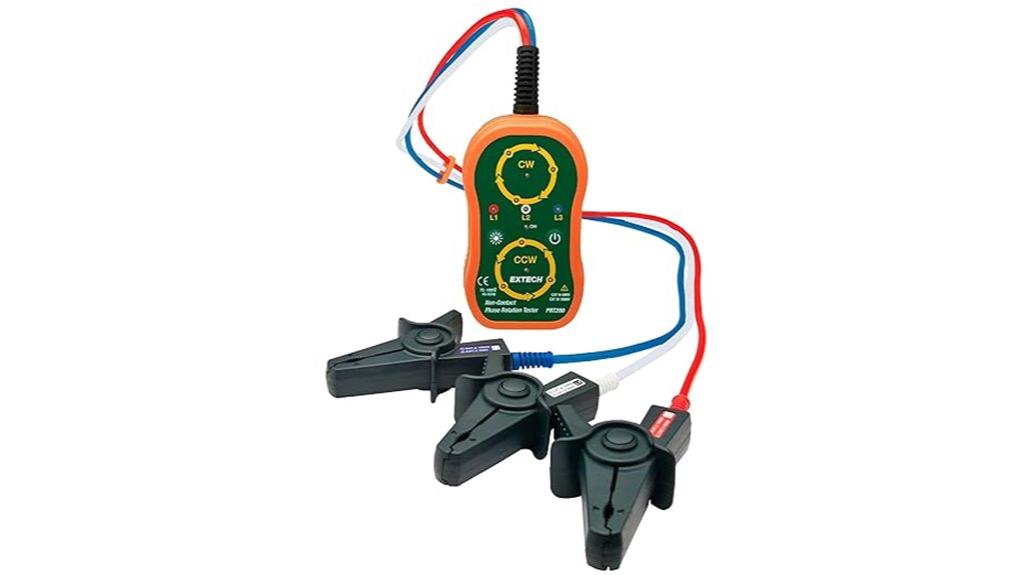
If you’re working with complex electrical systems and need a reliable way to verify phase orientation, the Extech PRT200 Non-Contact Phase Sequence Tester is an excellent choice. It tests up to 1000VAC and operates within 75 to 1000VAC, with a frequency range of 45 to 65Hz. LEDs clearly indicate phase direction and whether each phase is live, while an intermittent beep confirms correct phase, turning continuous if reversed. Its durable design includes insulated alligator clips, a magnet for attachment, and a portable case. Powered by four AA batteries with a low battery warning, it’s a practical tool for ensuring safe, accurate phase verification in various environments.
Best For: electricians, electrical technicians, and maintenance professionals needing accurate, non-contact phase verification in residential, commercial, or industrial settings.
Pros:
- Easy to use with clear LED indicators and audible signals for quick phase verification
- Fully insulated alligator clips and magnetic housing for safe and convenient testing in various environments
- Portable with test leads and case included, powered by long-lasting AA batteries
Cons:
- Limited to voltage testing within 75 to 1000VAC, not suitable for low-voltage applications
- Requires batteries, which may need replacement over time
- May produce false readings if the test leads or clips are not properly connected
Factors to Consider When Choosing High‑End DNA Sequencers
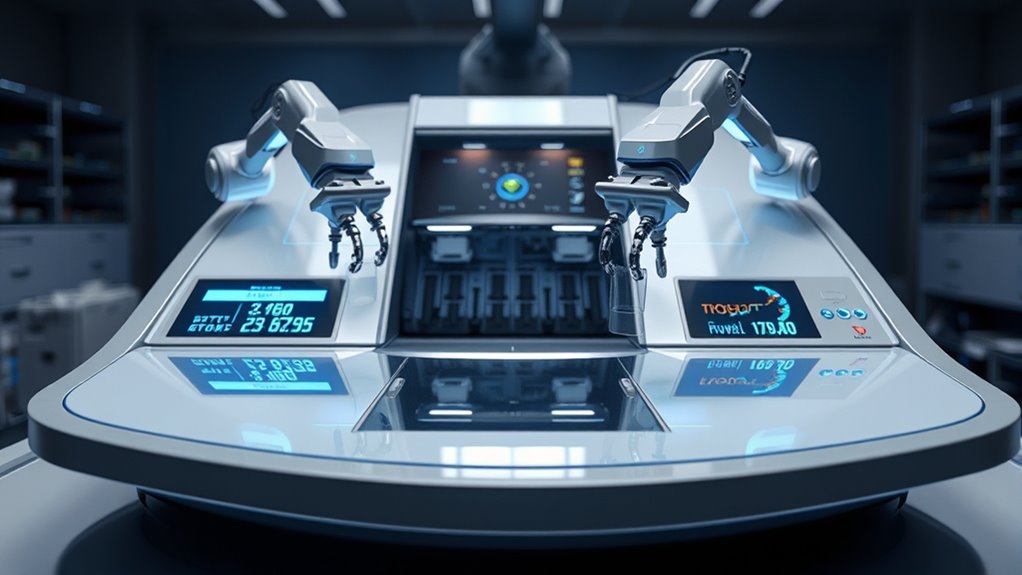
When selecting a high-end DNA sequencer, I focus on key factors like sequencing accuracy standards, throughput, and read length capabilities to match my project’s needs. I also consider the data analysis tools available and how they integrate with the equipment to streamline workflows. Finally, I keep an eye on costs and budgeting to guarantee I choose a solution that offers value without overspending.
Sequencing Accuracy Standards
Choosing a high-end DNA sequencer requires careful attention to accuracy standards, as even small errors can compromise the reliability of genetic data. Typically, top-tier platforms aim for accuracy rates of 99.9% or higher to reliably identify genetic variants. Validation involves benchmark datasets and comparisons to reference genomes, which help assess error rates across different systems. Factors like base-calling algorithms and error correction methods play a crucial role in ensuring high accuracy. Longer read lengths can sometimes decrease precision due to increased error rates, so balancing read length with sequencing accuracy is vital. For clinical applications, maintaining consistent accuracy standards is vital, as even minor errors can impact diagnosis and treatment. Prioritizing these accuracy measures helps ensure dependable, actionable genetic insights.
Throughput and Speed
High-end DNA sequencers are designed to process vast amounts of genetic data rapidly, which is vital for large-scale projects and clinical applications. They can sequence entire genomes in hours to days, drastically reducing turnaround times. Throughput varies among models, with advanced systems capable of generating terabases of data per run, supporting extensive genomic research. Faster sequencing speeds allow more samples to be processed simultaneously, boosting laboratory productivity and experimental throughput. The number of flow cells or channels directly influences speed and capacity, with higher channel counts increasing throughput. However, optimizing throughput and speed involves balancing sequencing accuracy, data quality, and instrument performance. This balance ensures that projects meet timelines without sacrificing reliability, making throughput and speed key factors when selecting a high-end DNA sequencer.
Read Length Capabilities
Read length is a crucial factor to take into account because it determines how much genetic information a sequencer can accurately read in a single pass. High-end sequencers can achieve read lengths from several thousand to over 100,000 base pairs, especially in long-read technologies. Longer reads improve genome assembly, help identify structural variants, and resolve repetitive regions more effectively. These sequencers often use specialized chemistries and optics to reduce errors over extended DNA stretches, ensuring accuracy. The ability to read longer fragments impacts detailed genetic analyses like de novo assembly and haplotype phasing. When selecting a high-end sequencer, consider the maximum read length to match your project’s complexity and the level of detail needed for thorough genomic insights.
Data Analysis Tools
When evaluating data analysis tools for high-end DNA sequencers, it’s vital to take into account how well the software integrates with your workflow and facilitates accurate interpretation of complex datasets. I look for advanced features like real-time visualization, variant calling, and quality control metrics to guarantee results are reliable. Compatibility with common bioinformatics formats such as FASTQ, BAM, and VCF is essential for smooth downstream analysis. Cloud-based options appeal to me because they enable remote collaboration and large-scale data processing without heavy local infrastructure. User-friendly interfaces and customizable algorithms also matter, as they help optimize workflows and reduce reliance on extensive computational expertise. Ultimately, choosing sequencers with robust, adaptable analysis tools ensures I get the most accurate insights from my sequencing data.
Cost and Budgeting
Choosing the right DNA sequencer isn’t just about its advanced features; it also involves careful financial planning. High-end sequencers can cost anywhere from hundreds of thousands to millions of dollars, so it’s essential to consider your budget from the start. Remember, the initial purchase price isn’t the only expense—maintenance, reagents, software updates, and operational costs add up quickly. You’ll want to assess whether the sequencer’s throughput and capabilities align with your research needs to avoid overspending on unnecessary features. Conducting a thorough cost-benefit analysis helps determine if the advanced features justify the higher price compared to mid-range options. Additionally, securing funding or grants can be critical to support both acquisition and ongoing expenses, ensuring your investment remains sustainable over time.
Compatibility and Integration
Selecting a high-end DNA sequencer requires careful attention to its compatibility with your existing laboratory infrastructure. I look for support for standard data formats like FASTQ, BAM, and VCF to guarantee smooth integration with my bioinformatics pipelines. Compatibility with laboratory information management systems (LIMS) is essential for efficient sample tracking, data management, and workflow automation. I also prioritize integration with cloud storage platforms, which enables remote data analysis, sharing, and collaboration with my team. Automation and robotics integration are equally important, as they help increase throughput and minimize manual errors. Additionally, supporting various library preparation methods and sequencing chemistries provides the flexibility needed to meet diverse research and clinical demands. Ultimately, seamless compatibility and integration streamline my workflow and improve overall efficiency.
Instrument Reliability
Ever wondered what makes a high-end DNA sequencer truly reliable? It starts with robust hardware designed to withstand continuous use and minimize failures. Advanced error correction algorithms play a crucial role by substantially reducing sequencing errors, which boosts data accuracy. Regular quality control checks and routine calibration are essential to keep the instrument performing at its best during heavy workloads. Durability is key, so top-tier sequencers are built with sturdy materials and sealed environments to prevent contamination and endure tough lab conditions. Additionally, comprehensive support and maintenance programs are vital, ensuring quick resolution of technical issues and consistent reliability. When choosing a high-end DNA sequencer, these factors help guarantee consistent, accurate results and uninterrupted operation over time.
Support and Service
When investing in a high-end DNA sequencer, reliable support and service are essential to keep the equipment running smoothly. Dedicated technical support teams are indispensable for troubleshooting, maintenance, and software updates, ensuring peak performance. Good support also includes comprehensive training programs and user manuals to help maximize data accuracy and instrument use. Many manufacturers offer extended warranties and rapid-response repair services, minimizing downtime during critical projects. On-site maintenance, calibration, and software upgrades are often part of extensive service plans, which help maintain consistent results and reduce operational disruptions. Access to prompt customer support is crucial for resolving complex issues and maintaining compliance with data security and quality standards. Ultimately, solid support and service are key to protecting your investment and enabling long-term success.
Frequently Asked Questions
What Advancements Are Expected in DNA Sequencing Speed by 2025?
By 2025, I expect DNA sequencing speeds to drastically improve, thanks to innovations like nanopore technology and enhanced automation. These advancements will allow us to sequence entire genomes in a matter of hours or even minutes, making research faster and more efficient. The focus will be on increasing throughput without sacrificing accuracy, enabling personalized medicine and large-scale studies to become more practical and accessible across various fields.
How Will AI Integration Improve High-End DNA Sequencers?
Ever wonder how AI will revolutionize high-end DNA sequencers? It’ll make them smarter and faster, I believe. AI integration enables real-time data analysis, reducing errors and increasing accuracy. It also helps in identifying complex genetic patterns quickly. This means scientists like me can focus more on insights rather than data crunching. Do you see how AI can turn sequencing from a tedious task into a powerful discovery tool?
What Are the Environmental Impacts of Next-Gen DNA Sequencing Technologies?
Next-gen DNA sequencing technologies can impact the environment in both positive and negative ways. I believe they may reduce waste by being more efficient, but they also require significant energy, which can increase carbon footprints if not managed properly. It’s vital for us to develop greener processes and energy sources to minimize environmental harm. Overall, responsible innovation can help balance scientific progress with sustainability.
How Do High-End Sequencers Enhance Data Security and Privacy?
You might think high-end sequencers are just about accuracy, but they actually do wonders for data security too. I’ve seen how they use encryption and strict access controls to keep genetic data safe, making sure your privacy isn’t just an afterthought. These machines actively guard sensitive info, giving you peace of mind that your DNA sequences are protected from prying eyes, all while delivering top-tier precision.
What Cost Reductions Are Anticipated for Commercial DNA Sequencing?
I believe that as technology advances, costs for commercial DNA sequencing will considerably drop. We’re seeing reductions in reagent and equipment expenses, plus increased automation. These changes make sequencing more accessible and affordable for a wider range of industries. I expect economies of scale and ongoing innovation to continue driving down prices, allowing more researchers and companies to leverage DNA analysis without breaking the bank.
Conclusion
Choosing the right high-end DNA sequencer is like selecting a finely tuned instrument; it requires careful thought and understanding of your needs. By considering accuracy, speed, cost, and reliability, you’ll find a device that fits seamlessly into your research. Remember, the best sequencer isn’t just powerful—it’s a trusted partner in your scientific journey. With the right choice, you’ll unleash new frontiers in precision, much like a master pianist unlocking a symphony’s full potential.



